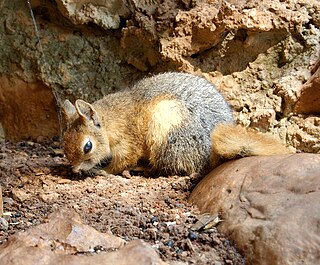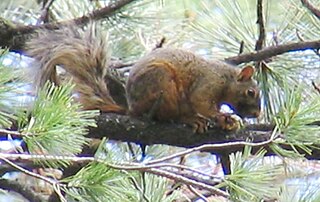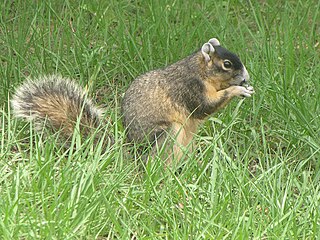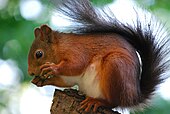
The western gray squirrel is a tree squirrel found along the western coast of the United States and Mexico. In some places, this species has also been known as the silver-gray squirrel, the California gray squirrel, the Oregon gray squirrel, the Columbian gray squirrel and the banner-tail. There are three geographical subspecies: Sciurus griseus griseus ; S. g. nigripes ; and S. g. anthonyi.

The fox squirrel, also known as the eastern fox squirrel or Bryant's fox squirrel, is the largest species of tree squirrel native to North America. Despite the differences in size and coloration, it is sometimes mistaken for American red squirrels or eastern gray squirrels in areas where the species co-exist.

The genus Sciurus contains most of the common, bushy-tailed squirrels in North America, Europe, temperate Asia, Central America and South America.

Abert's squirrel or the tassel-eared squirrel is a tree squirrel in the genus Sciurus native to the southern Rocky Mountains from the United States to the northern Sierra Madre Occidental of Mexico, with concentrations found in Arizona, New Mexico, and southwestern Colorado. It is closely associated with, and largely confined to, mature ponderosa pine forests. It is named in honor of the American naturalist John James Abert; nine subspecies are recognised. It is recognizable by its tufted ears, gray color, pale underparts and rufous patch on the lower back. The squirrel feeds on the seeds and cones of the Mexican pinyon and the ponderosa pine when they are available, but will also take fungi, buds, bark, and carrion. Breeding normally occurs in summer, with a spherical nest being built high in the canopy.

The Bolivian squirrel is a tree squirrel that is endemic to South America. Little is known of the species, which may represent a species complex.

Bangs's mountain squirrel is a poorly known species of tree squirrel, that only lives in Costa Rica and Panama. It can be found in mountain rain forests at an altitude between 1,900 and 2,600 metres, and lives mainly in the tree tops, but sometimes on the forest floor as well. One of its habitats is at the summit of the Poás Volcano in Costa Rica, in a Clusia forest that is almost inaccessible to humans.

Callosciurus is a genus of squirrels collectively referred to as the "beautiful squirrels". They are found mainly in Southeast Asia, though a few species also occur in Nepal, northeastern India, Bangladesh and southern China. Several of the species have settled on islands. In total, the genus contains 15 species and numerous varieties and subspecies. The genera Glyphotes, Rubrisciurus, and Tamiops have sometimes been included in Callosciurus.

The Caucasian squirrel or Persian squirrel, is a tree squirrel in the genus Sciurus found in temperate broadleaf and mixed forests in south-western Asia.

The Arizona gray squirrel is a tree squirrel, in the genus Sciurus, endemic to the canyons and valleys surrounded by deciduous and mixed forests in eastern Arizona and northern Mexico.

Deppe's squirrel is a species of tree squirrel in the genus Sciurus native to Belize, Costa Rica, El Salvador, Guatemala, Honduras, Mexico, and Nicaragua.

The red-tailed squirrel is a species of tree squirrel distributed from southern Central America to northern South America.

The Mexican fox squirrel is a species of tree squirrel found throughout the Sierra Madre Occidental of Mexico as far south as Jalisco — and northward into the Chiricahua Mountains of southeastern Arizona, U.S.

Peters's squirrel is a tree squirrel in the genus Sciurus endemic to Mexico. It was first described by the German naturalist and explorer Wilhelm Peters in 1863. Three subspecies are recognised. It is a common species, and the IUCN has rated its conservation status as being of "least concern".

The variegated squirrel is a tree squirrel in the genus Sciurus found in Costa Rica, El Salvador, Guatemala, Honduras, southern Mexico, Nicaragua, and Panama. Fifteen subspecies are recognised. It is a common squirrel and the International Union for Conservation of Nature has rated it a "least-concern species". Variegated squirrels kept as pets in Germany have been implicated in the transmission of a bornavirus to humans from which three people have died.

The Yucatan squirrel, originally named the Yucatan gray squirrel, also once named the Campeche squirrel, is a tree squirrel in the genus Sciurus found in the Yucatán Peninsula and adjacent areas. It is native to northern Belize, northeastern Guatemala, and southeast Mexico.

Mearns's squirrel is a subspecies of the Douglas squirrel endemic to Mexico. It is endangered and occurs in low densities, and is threatened by habitat loss. It is possibly also threatened by competition from the eastern gray squirrel, which was introduced to the range of Mearns's squirrel in 1946, but may not be present anymore. It is closely related to other subspecies of the Douglas squirrel, but far less is known about its behavior, which was first studied in detail in 2004. It is named for the 19th-century American naturalist Edgar Mearns.

Sherman's fox squirrel is a subspecies of the fox squirrel. It lives in the U.S. states of Florida and Georgia in fire-prone areas of longleaf pine and wiregrass, especially around sandhills. A tree squirrel, Sherman's fox squirrel has lost much of its habitat to farming and development. This type of squirrel nests in oak trees using leaves and Spanish moss.

Thrinax radiata, also known as the Florida thatch palm, is a medium to slow growing palm in the family Arecaceae. It is native to many Caribbean islands, Mexico, Central America, and far southern Florida. Its natural habitat is sandy, calcareous soil in coastal areas.
























